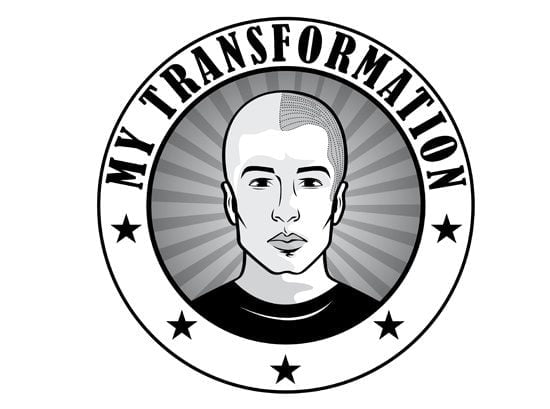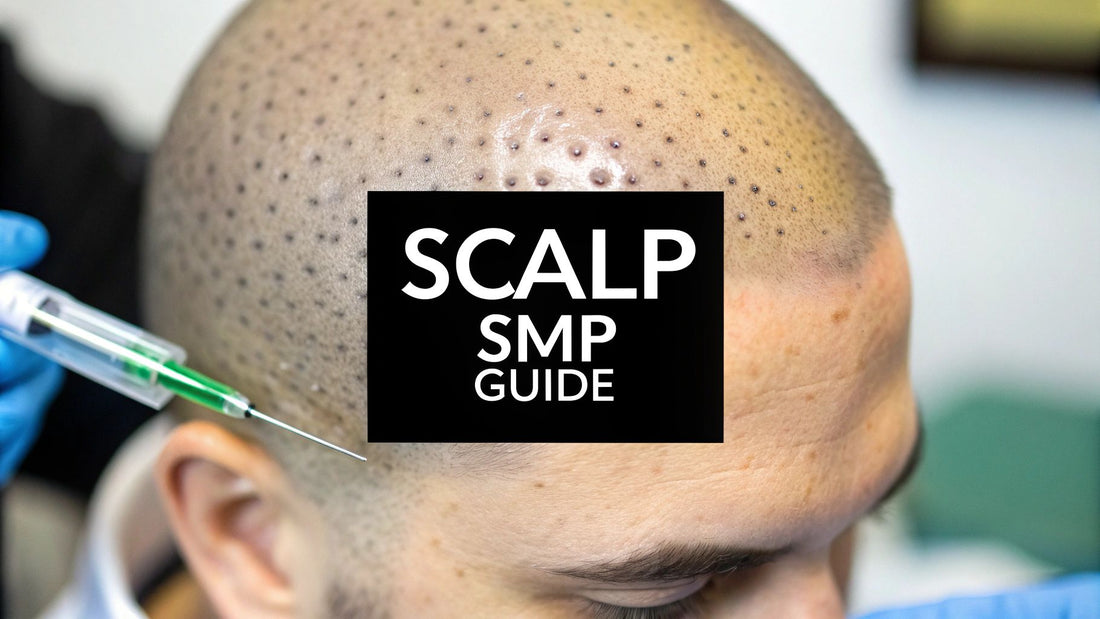
Scalp Micropigmentation for Scalp: The Ultimate Hair Loss Guide
Share
If you're looking for a way to deal with hair loss, you’ve probably seen it all – from lotions and potions to surgical options. But there's another solution that's gaining serious traction: scalp micropigmentation, or SMP. It's a game-changer for so many people.
So, what exactly is it? Think of SMP as a highly advanced form of cosmetic tattooing, but one designed purely for the scalp. It’s a non-surgical treatment where tiny, layered dots of pigment are applied to the scalp to replicate the look of real hair follicles. The result? You can create the illusion of a full, closely-shaved head of hair, or add the appearance of density to thinning areas.
The Ultimate Guide to Scalp Micropigmentation
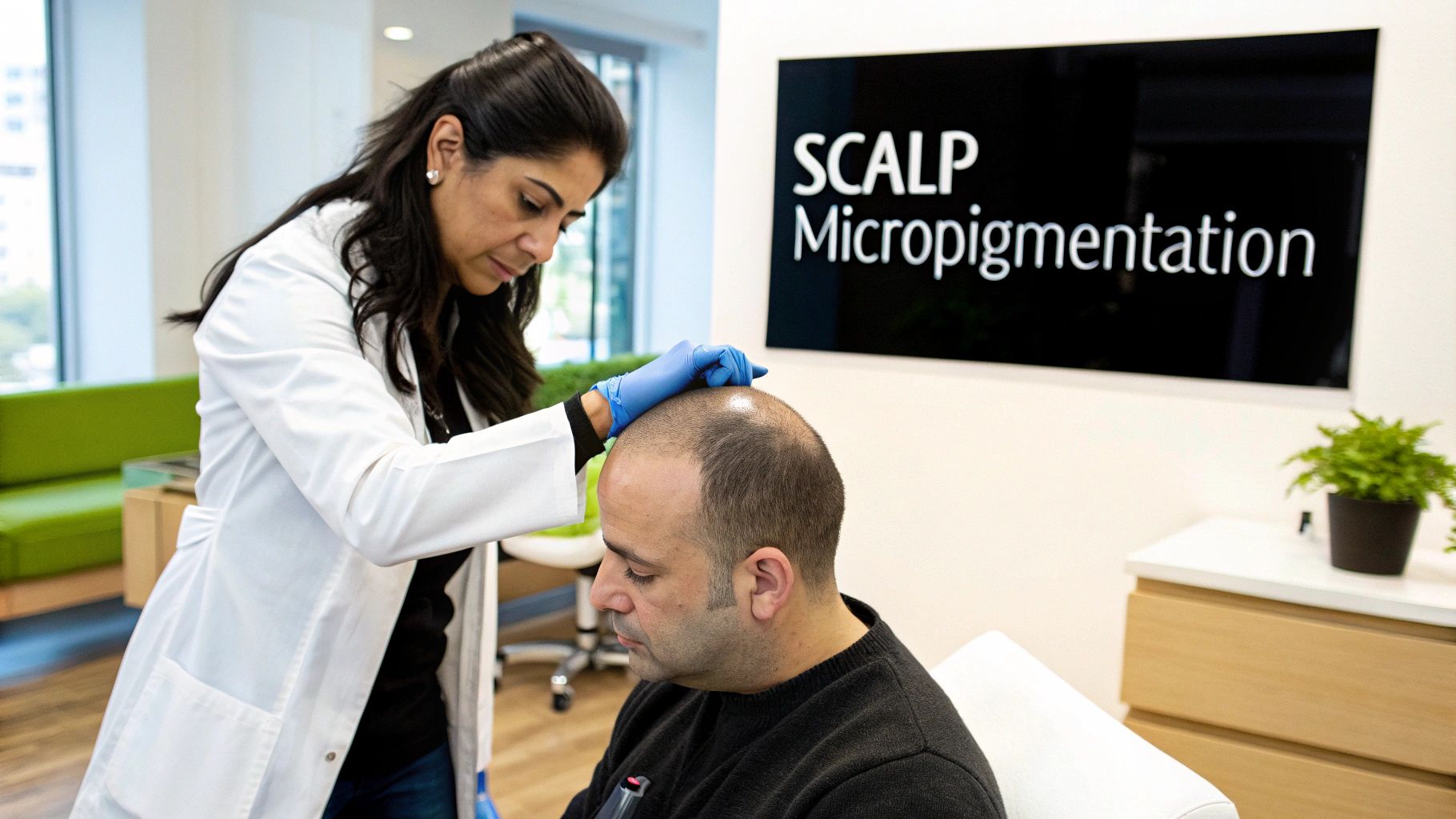
While the idea of a "hair tattoo" might sound simple, micropigmentation for scalp is a sophisticated art form. It's worlds away from a standard body tattoo. A trained specialist uses micro-fine needles and specialised pigments to meticulously place thousands of tiny impressions into the upper layer of the scalp.
The best way to picture it is like the art technique of pointillism, where a skilled artist uses countless tiny dots of colour to build a complete, detailed picture. Each dot in SMP is strategically placed to mimic a natural hair follicle, and together they create a seamless, incredibly realistic impression of a full head of hair. This level of detail is what makes all the difference.
Who Is a Candidate for SMP?
One of the great things about scalp micropigmentation is how versatile it is. It's not a one-size-fits-all fix; it’s a bespoke treatment that can be tailored to solve a whole range of hair loss issues.
You might be the perfect candidate if you're dealing with:
- Male Pattern Baldness: SMP is fantastic for rebuilding a receding hairline or creating a sharp, clean buzz-cut look. It’s effective for men at any stage of hair loss, right across the Norwood scale.
- Thinning Hair in Women: For women with diffuse thinning, SMP can work wonders. By adding pigment between the existing hairs, it reduces the noticeable contrast between the hair and scalp, making hair look instantly thicker and fuller.
- Scar Concealment: Scars from injuries or hair transplant surgery (both FUT and FUE) can be a real confidence-killer. SMP is incredibly effective at camouflaging them, blending them seamlessly into the surrounding hair.
- Alopecia Areata: For those with the patchy hair loss typical of alopecia, SMP can be used to fill in the gaps, creating a consistent and even look across the entire scalp.
If you want to dive deeper into this, we have a detailed guide that explores who can benefit from hair tattoos and covers these situations in more detail.
What SMP Is and What It Is Not
It’s so important to go into any treatment with the right expectations. Let’s get a few things straight about what SMP is really about.
Scalp micropigmentation is not a hair growth treatment; it is a cosmetic solution that masterfully conceals hair loss. Its power lies in creating a hyper-realistic illusion that restores the appearance of a full head of hair.
To help clear things up, it helps to see a direct comparison between what the treatment actually is versus some common myths.
Scalp Micropigmentation At a Glance
Here’s a quick summary to bust some myths and get straight to the facts.
| What SMP Is | What SMP Is Not |
|---|---|
| A specialised cosmetic procedure using micro-dots of pigment. | A traditional body tattoo with solid lines or shading. |
| A semi-permanent solution that lasts for years with minimal fading. | A temporary fix like hair fibres or sprays that wash out daily. |
| A technique that creates the illusion of hair follicles on a bald scalp. | A medical procedure that grows new hair or stops hair loss. |
| Performed by a certified SMP artist with specialised equipment. | Performed by a standard tattoo artist using regular ink and needles. |
Ultimately, knowing these key differences helps you understand the incredible potential of SMP and decide if it's the right path for you.
The SMP Journey: From Consultation to Final Result
Getting a micropigmentation for scalp treatment isn't a single, one-and-done appointment. Think of it more as a creative project you undertake with a skilled artist, carefully planned from the first chat right through to the finished look. Each step is deliberately designed to build on the last, ensuring the final result is natural, seamless, and tailored just for you.
The whole thing kicks off with a really important consultation. This isn't just about booking a time; it's a strategic session where you and your artist get on the same page. You'll go over your hair loss situation, what you're hoping to achieve, and the exact look you're after.
Your Initial Consultation and Design
During this first meeting, the practitioner will take a close look at your scalp, assess your skin tone, and examine any hair you have left. This is where the real artistry kicks in. Together, you’ll design a hairline that fits you perfectly—whether you want something soft and understated or a sharper, more defined edge.
The artist will also mix a custom pigment blend. This isn't about just picking a colour off a chart. It’s a meticulous process of creating the perfect shade to match your natural hair colour and skin undertones, making sure the final look blends in flawlessly. This is also your time to ask absolutely anything that's on your mind and get completely comfortable with what's ahead.
The consultation is the cornerstone of a successful SMP treatment. It aligns your vision with the artist's expertise, creating a clear blueprint for the sessions ahead and ensuring there are no surprises along the way.
The goal is to walk out of this session knowing exactly what to expect and feeling confident in the outcome. To make sure you get the most out of this first step, it’s a great idea to come prepared. Have a look at our detailed guide on how to prepare for scalp micropigmentation treatment before your appointment.
Building the Foundation: The First Session
Your first treatment is all about laying the groundwork. Using the hairline design and custom pigment you both agreed on, the artist will begin applying the foundational layer of tiny follicle impressions.
This session basically establishes the shape and basic structure of your new look. The pigment is applied quite conservatively because the aim is to build up the density slowly and naturally over time. You can expect a bit of redness straight after, but this usually settles down within 24-48 hours. This first pass sets the stage for the depth and realism that will be added in the next sessions.
The infographic below highlights some of the key benefits you'll see from this multi-session approach.
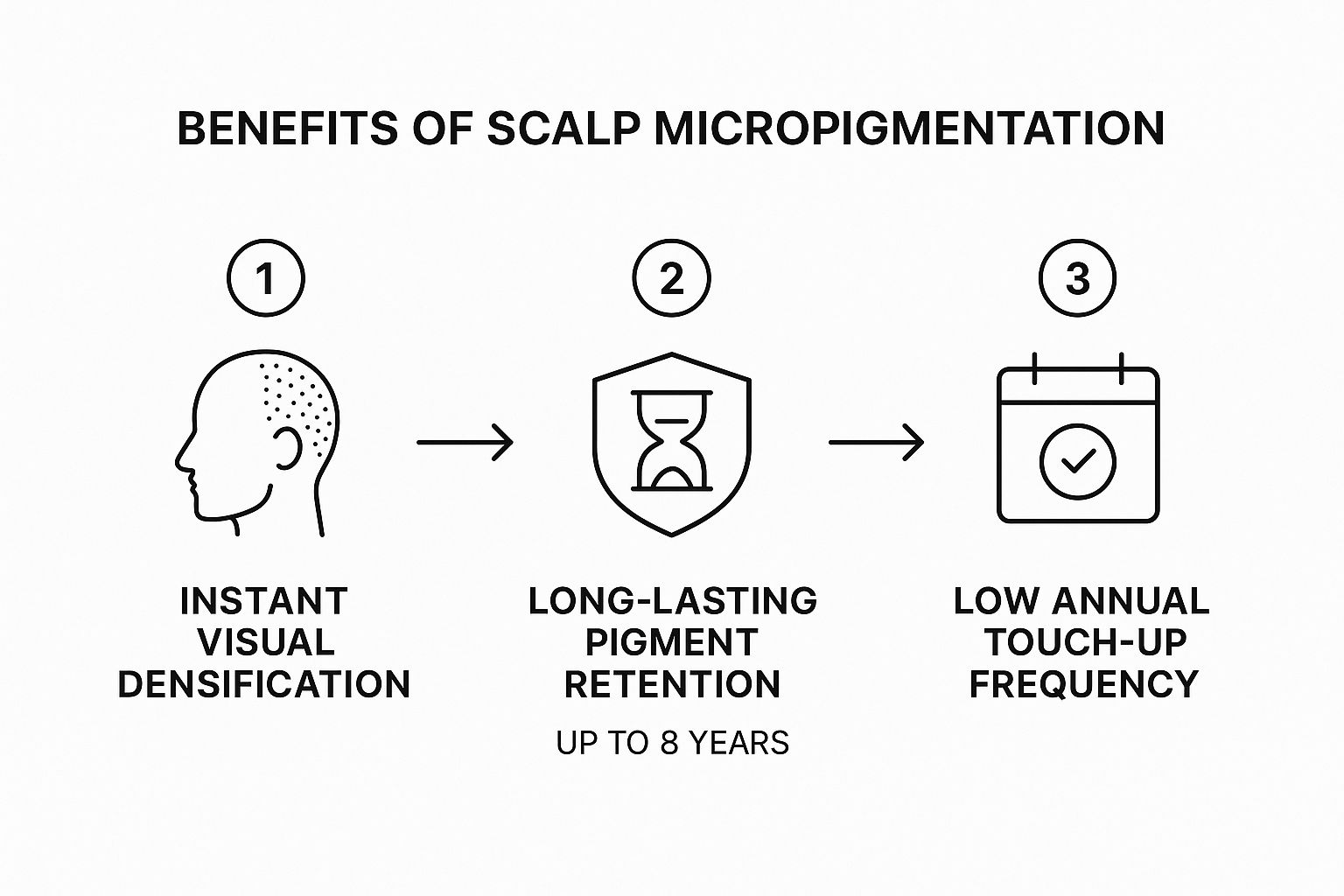
As you can see, the journey doesn't just give you an instant cosmetic boost; it provides a lasting, low-maintenance solution.
Adding Density and Detail: Subsequent Sessions
The secret to truly realistic scalp micropigmentation is layering. This is where the real magic happens, in the sessions that follow, usually scheduled 10-14 days apart. Your artist will skilfully add new impressions between the ones from the first session, creating a much richer, three-dimensional effect that mimics real hair.
These follow-up appointments are crucial for a few reasons:
- Building Density: Each new layer adds to the illusion of fullness, covering any scalp visibility and giving you that dense, 'buzzed' look.
- Adding Texture: By using slightly different shades and careful placement, the artist creates the subtle, natural variations you'd see in a real head of hair.
- Perfecting the Look: These sessions give the artist the chance to make small adjustments, ensuring every last detail is spot-on for a flawless finish.
Most people need between 2-4 sessions to achieve the final, desired result. This layered approach is precisely what makes SMP look so hyper-realistic, and it's why you can't rush the process. It's the only way to guarantee a result that’s undetectable and looks completely natural.
What Are the Real Benefits of Scalp Micropigmentation?
So, why are so many people looking into micropigmentation for the scalp instead of other hair loss treatments? It really comes down to a few powerful benefits that tackle the biggest frustrations of hair loss head-on, blending practicality with genuine artistry. SMP gives you immediate results, long-term reliability, and doesn't turn your life upside down.
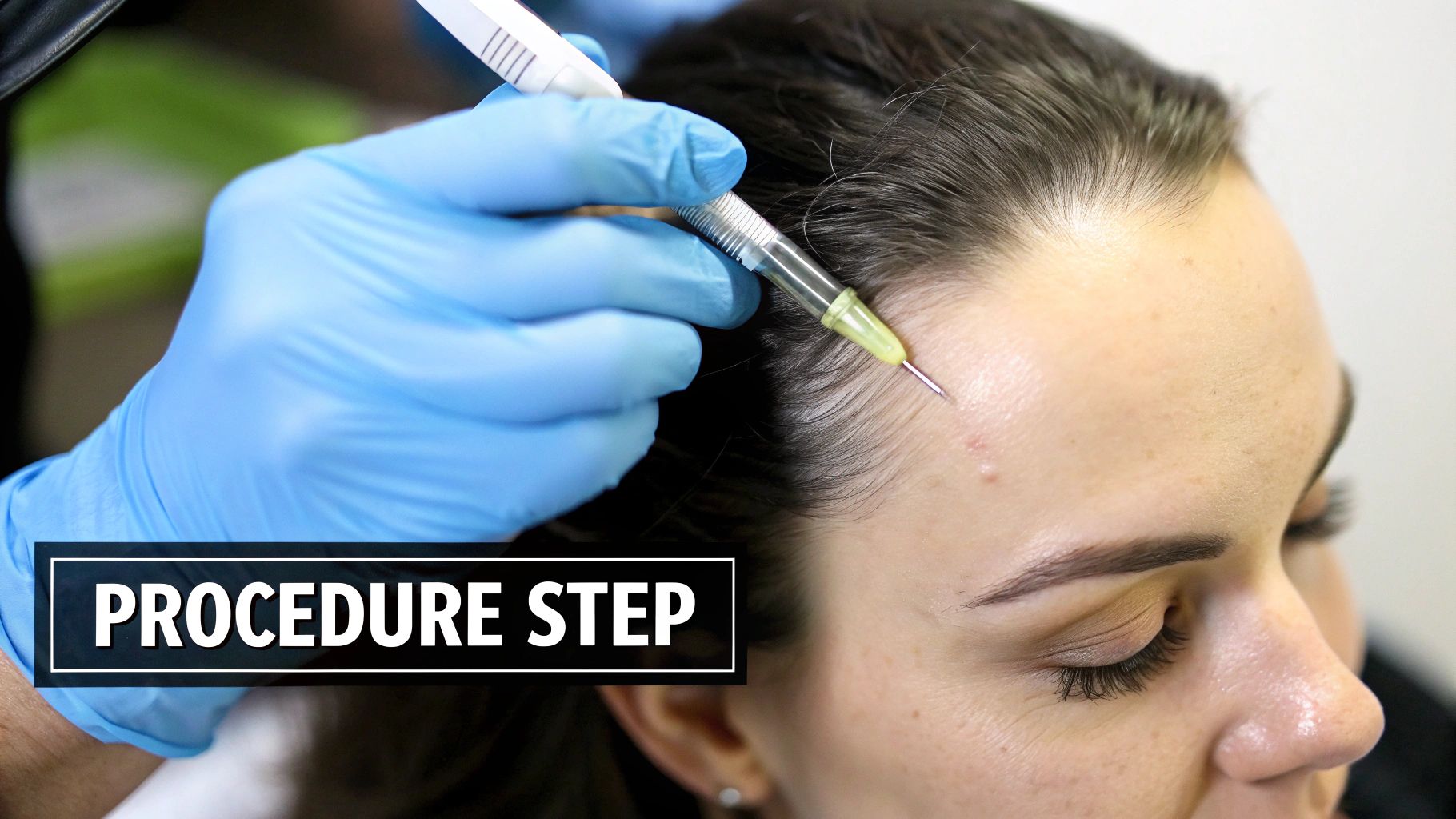
Think about it: pharmaceutical treatments can take months before you see any change, and hair transplants involve a long, uncomfortable recovery. With SMP, you see a difference right after your first session. You walk out of the clinic with a newly defined hairline and the foundation of your new look already taking shape.
A Non-Invasive and Reliable Solution
One of the biggest draws is that SMP is a non-surgical procedure. There are no cuts, no stitches, and you don’t need any donor hair. This immediately takes surgical risks like infection or scarring completely off the table, making the whole experience much safer and more comfortable.
The technique itself involves placing tiny dots of pigment into the upper layer of the skin, which is far less invasive than a traditional transplant. For many, this alone is the deciding factor.
Scalp micropigmentation delivers predictable, controlled results. Unlike a hair transplant where you’re hoping the grafts will 'take', SMP provides a guaranteed outcome that you and your artist design together right from the start.
This level of certainty is a huge relief. The treatment's popularity is growing fast, and it’s now seen as a genuinely effective solution for hair loss. The Australian SMP market is part of a booming global industry, cementing its place as a top alternative to surgical and medical options. To get a sense of its worldwide impact, you can read more about the growing demand and trends of Scalp Micropigmentation.
Long-Lasting Results with Almost No Fuss
Imagine a hair loss solution you don't have to think about every day. That's the kind of freedom SMP offers. Once your sessions are done, the look is there to stay for years, and it needs very little from you.
Forget about the daily grind of applying topical solutions or the constant maintenance that comes with a hair system. SMP is a true "get up and go" solution.
The long-term care is incredibly simple:
- Sun Protection: Always apply a high-SPF sunscreen to your scalp. This is key to stopping the sun’s UV rays from fading the pigment over time.
- Moisturising: Keeping your scalp hydrated is great for your skin and helps the pigment stay looking fresh and vibrant.
- Occasional Touch-Ups: To keep it looking razor-sharp, a quick touch-up session is usually recommended every 4-6 years.
This low-maintenance lifestyle is a perfect match for anyone with a busy schedule, saving you time, money, and a lot of stress down the road.
A Versatile Fix for Any Hair Loss Scenario
Scalp micropigmentation isn't just a one-size-fits-all solution; it's incredibly versatile and can be adapted to almost any hair loss pattern or situation. It doesn’t matter if you’re just starting to notice thinning or if you have advanced balding—it works.
For instance, a guy in the early stages of a receding hairline can use SMP to subtly fill in and strengthen his existing hairline, making it look fuller. On the other hand, someone with extensive baldness can get a clean, sharp, and totally natural-looking buzz cut.
But its uses go even further:
- Adding Density: For men and women with thinning hair, SMP reduces the colour contrast between the scalp and the hair. This clever trick creates an illusion of much greater thickness and density.
- Concealing Scars: It’s brilliant for camouflaging scars, whether they're from old hair transplant procedures (FUT or FUE) or accidents. The pigment blends the scar tissue seamlessly into the scalp.
This adaptability means almost anyone dealing with hair loss can find a solution in SMP, helping them get back not just the look of a full head of hair, but a serious and often life-changing boost in confidence.
Understanding SMP Costs in Australia

When you start looking into scalp micropigmentation, one of the first questions you’ll probably have is, "How much is this going to cost me?". It's a fair question, but in Australia, there's no simple price tag for SMP. Every treatment is completely customised to you and your specific hair loss situation.
Think of it less as a recurring expense and more as a one-off investment in your confidence. When you weigh it against the endless cycle of buying hair fibres or paying for medicated treatments, the value becomes pretty clear. The final figure on your quote comes down to a few key variables your practitioner will walk you through during a consultation.
Key Factors That Determine Your SMP Price
The total cost is a direct reflection of the skill, time, and attention to detail your treatment requires. Getting a grasp on these factors helps explain why clinics provide a personalised quote rather than a generic fee.
- Extent of Hair Loss: This is the biggest piece of the puzzle. A practitioner typically uses the Norwood scale to gauge the level of male pattern baldness. Someone with a slightly receding hairline (Norwood 2) will naturally need less work—and a smaller investment—than someone with significant hair loss across the scalp (Norwood 6-7).
- Size of the Treatment Area: It all comes down to surface area. The more scalp that needs covering, the longer your sessions will take. Treating the entire top of the head is a much bigger job than just touching up a small crown area or rebuilding a hairline.
- Scar Concealment: Working on scar tissue is a specialised skill. Whether it’s from an old injury or a hair transplant (FUT or FUE), blending pigment into dense, fibrous tissue requires a different technique. This extra complexity and time will usually influence the overall cost.
Typical Price Ranges in Australia
While you’ll find some variation between clinics in major cities like Perth, Sydney, and Melbourne, a good ballpark for a full scalp micropigmentation procedure is between $2,500 and $6,000 AUD. Of course, smaller jobs like minor scar work might come in below this, while very complex cases could be higher.
It’s so important to remember that SMP is a highly skilled art form. The price reflects the artist’s experience, the quality of the tools and pigments, and the clinical, sterile environment—all non-negotiables for a safe procedure and a realistic result.
The demand for SMP in Australia is on the rise, mirroring a global shift toward effective, non-surgical hair loss solutions. While hard national data is tricky to pin down, Australia is a major market alongside the UK and the US. The price reflects not only the incredible artistry involved but also the growing confidence people have in SMP as a lasting solution.
The table below gives you a clearer picture of how the stage of your hair loss can affect the price. For a much more detailed breakdown, have a look at our in-depth article on scalp micropigmentation cost.
Estimated SMP Cost Based on Hair Loss Level (Norwood Scale)
This table gives a general idea of how the extent of hair loss, classified by the Norwood Scale, can influence the number of sessions and the final cost.
| Norwood Scale Stage | Typical Treatment Area | Estimated Sessions | Estimated Cost Range (AUD) |
|---|---|---|---|
| Norwood 2-3 | Receding hairline and temples | 2-3 | $1,200 - $2,800 |
| Norwood 4-5 | Hairline, temples, and crown | 3-4 | $2,800 - $4,500 |
| Norwood 6-7 | Full scalp coverage | 3-4 | $4,000 - $6,000+ |
| Scar Camouflage | Varies depending on scar size and type | 1-3 | $800 - $2,500 |
Keep in mind these are estimates. Your individual needs, skin type, and desired look will all be considered in your personal quote.
SMP Aftercare and Long-Term Maintenance
Walking out of the clinic after your final session feels fantastic, but your SMP journey isn't quite over. Think of the aftercare period as the final, crucial step in locking in your results. What you do in the first few days and weeks directly impacts how sharp and long-lasting your new look will be.
Getting this part right is simple, but it's non-negotiable for a perfect outcome. Your scalp needs a little time to heal and for the pigment to settle in properly.
Your Immediate Aftercare Timeline
To make it easy, we've broken down the do's and don'ts for the period right after each of your SMP sessions.
The First 4 Days
This is the hands-off, "do nothing" phase. Your primary goal is to keep your scalp clean, dry, and undisturbed while the tiny micro-impressions heal.
- Absolutely No Water: Don't wash your head or even let the shower stream run over it. Keep it completely dry.
- Avoid Sweating: This is a big one. You need to skip the gym, saunas, or any heavy work that gets you sweating. Sweat can literally push the pigment out of the skin before it settles.
- Keep Your Hands Off: You'll probably be tempted to touch or scratch your scalp, but you must resist. Let it heal on its own.
- Shun the Sun: Stay out of direct sunlight as much as possible. If you have to be outside, a loose-fitting hat is your best friend.
Once you’re past this initial window, you can slowly start getting back to normal.
Proper aftercare isn't just a friendly suggestion—it's an essential part of the process. How you treat your scalp in this first week will make or break the crispness, colour, and overall success of your treatment.
From Day 5 to Day 10
Your scalp is now well on its way to healing. You can carefully reintroduce a few things back into your routine.
- You can now give your head a gentle rinse with water. Hold off on any shampoos or soaps for a little longer, though.
- Light exercise is usually fine at this point, but still try to avoid anything that leads to heavy sweating.
- It's common to feel some itchiness as the skin heals. Don't scratch it. Instead, applying a light moisturiser can provide some relief.
Following these guidelines lays the groundwork for a fantastic, long-lasting result. For an even more detailed breakdown, have a look at our guide on the 5 top tips to care for your scalp after SMP.
Long-Term Maintenance for Lasting Vibrancy
Once everything is fully healed (about a month after your final session), looking after your SMP is incredibly straightforward. Micropigmentation for the scalp is designed to be a low-maintenance solution, but a couple of good habits will keep it looking fresh for the long haul.
Your number one enemy from here on out is the sun. UV radiation is the main culprit behind any pigment fading over time.
- Use High-SPF Sunscreen: Get into the daily habit of applying a sunscreen with SPF 30+ to your scalp. Do this every day, even when it's overcast. It's the single best thing you can do to protect your investment.
- Moisturise Regularly: Healthy, hydrated skin holds pigment better. A simple daily moisturiser will keep your scalp in great condition and help the treatment look its vibrant best.
- Plan for Touch-Ups: SMP is considered semi-permanent, which means it will gradually lighten over a long period. Most guys find they need a quick touch-up session every 4-6 years to bring back that original depth and definition. It's a simple way to keep your look sharp indefinitely.
How to Choose the Right SMP Artist
The success of your scalp micropigmentation isn’t just about the technique itself; it almost entirely comes down to the skill and artistry of the person holding the tool. A great artist creates a result so realistic it’s virtually undetectable. An inexperienced one, on the other hand, can leave you with a look you’ll regret. Vetting your potential artist is, without a doubt, the most important step you will take.
Don't let the price tag be your guide. Your decision should hang on proven expertise, specialised training, and a solid portfolio of their work. An artist's real-world experience is your best bet for a great outcome, so don’t be shy—dig deep and ask the tough questions before you commit.
Look for Specialised Training and Equipment
A true SMP professional is not just a regular tattoo artist. The craft demands completely different tools, needles, and pigments designed specifically for the delicate skin on your scalp.
Here’s what you need to look for:
- Dedicated SMP Equipment: They must be using purpose-built machines with micro-fine needles, not the heavy-duty guns used for body art.
- Specialised Pigments: Ask if their pigments are carbon-based. These are formulated to hold their intended colour and resist fading to strange shades of blue or green, which can happen with standard tattoo inks over time.
- Proper Certification: Always ask about their training and certification in scalp micropigmentation specifically.
It's so important to understand the difference between a tattoo artist and an SMP specialist. A true SMP artist knows scalp anatomy, how to match skin tones, and the fine art of replicating natural hair follicles—a skill set that’s miles apart from traditional tattooing.
Finding the right specialist is a critical step for any significant personal service. For general guidance on selecting a trusted professional, the core principles of checking credentials and experience apply here as well.
Scrutinise Their Portfolio and Reviews
An artist's portfolio of before-and-after photos is their resume. Don't just give it a quick glance; really study the images for realism. You want to see high-resolution photos from different angles and in various lighting conditions. Do the hairlines look natural and suit the person's age? Is the density of the dots blended seamlessly with their existing hair?
Client reviews give you another layer of truth. Look for detailed testimonials that walk you through the entire experience, from the first chat to the final result. While a couple of less-than-perfect reviews aren't always a deal-breaker, a pattern of complaints about unnatural results or sloppy service is a massive red flag.
If you’re trying to find the best scalp micropigmentation clinic near me, taking the time to read these reviews is worth its weight in gold. They offer honest, real-world feedback that can help you partner with a true professional who will deliver the results you're hoping for.
Your Scalp Micropigmentation Questions, Answered
It's completely normal to have a few questions buzzing around your head, even after getting a good sense of the SMP process. Thinking about the details, from how it feels to how it holds up over time, is a crucial part of feeling confident in your decision.
Let's dive into some of the most common things people ask.
Does Scalp Micropigmentation Hurt?
This is usually the first thing people want to know, and the answer is probably not what you'd expect. Most clients describe the feeling as a light, quick tapping or a bit of a mild annoyance—nothing like getting a traditional tattoo.
On a pain scale, it’s typically rated a 2 or 3 out of 10. To make sure you're as comfortable as possible, your practitioner will apply a strong topical numbing cream before they start. This takes the edge off significantly, making the whole thing feel pretty straightforward.
How Long Does SMP Last?
Think of scalp micropigmentation as a permanent solution for hair loss. The pigments used are specially designed to hold their colour and resist fading for years on end. They're much more stable than standard tattoo inks, which can often change colour over time.
Of course, nothing is completely immune to the effects of time. Sun exposure and your skin's natural exfoliation process will cause the treatment to gradually soften over the years.
While SMP is considered permanent, you'll want to think about occasional touch-ups to keep it looking sharp. A quick visit every 4-6 years is usually all it takes to refresh the colour and definition, ensuring it always looks its best.
This makes it an incredibly low-maintenance and dependable way to manage your appearance for the long haul.
Can SMP Look Natural on Any Skin or Hair Colour?
Yes, absolutely. The real magic of SMP is how it's tailored specifically to you. A great practitioner is a master of colour-matching, which means the treatment works for people of all ethnic backgrounds and hair colours.
They’ll create a custom pigment blend that perfectly matches your natural hair follicle colour while also complementing your skin tone. This detailed approach is what creates that seamless, ultra-realistic look that blends right in with any remaining hair. It doesn't matter if you're blonde, a redhead, or have dark brown hair—the treatment can be customised to look completely natural.
Ready to see how My Transformation can restore your confidence with a tailored scalp micropigmentation solution? Contact us today for a free consultation and start your journey.
